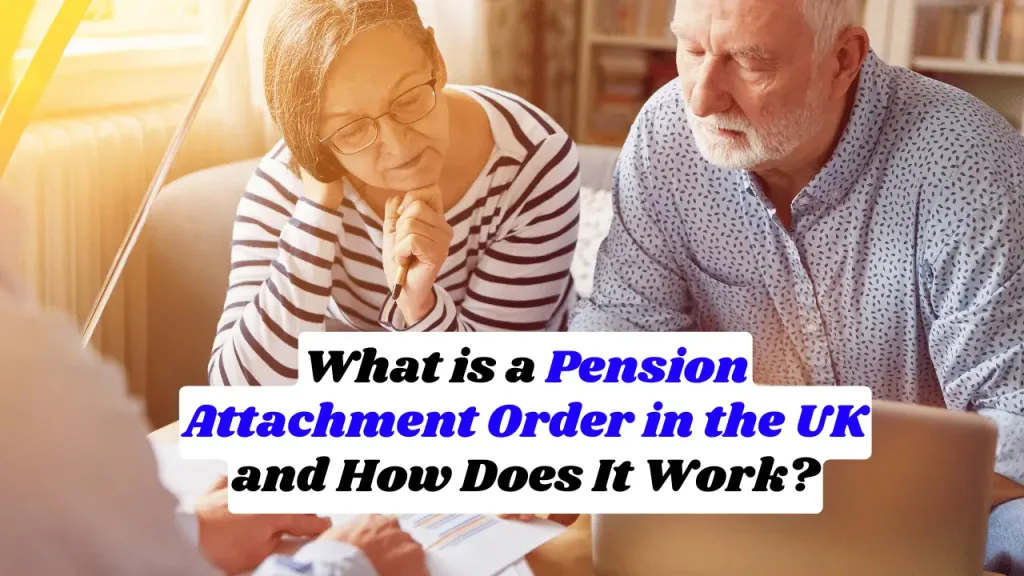What is a Pension Attachment Order in the UK and How Does It Work?
A Pension Attachment Order (formerly referred to as an Earmarking Order) is a legal mechanism in the UK used during divorce or dissolution proceedings to allocate a portion of one party’s pension benefits to their ex-spouse or civil partner. The court directs the pension provider to pay a percentage of the pension’s income, lump sum benefits, or death-in-service benefits to the recipient.
While Pension Attachment Orders provide financial security for the receiving party, they do not facilitate a clean financial break between ex-spouses. Instead, they maintain a financial connection, as the order depends on when the pension-holder accesses their benefits. This article explores the workings, benefits, and limitations of Pension Attachment Orders, comparing them to other pension arrangements like Pension Sharing Orders.
Table of Contents
Key Features of Pension Attachment Orders
- Payment Allocation
- A portion of the pension income when the pension is accessed.
- A share of lump sum retirement allowances.
- Death-in-service benefits in the event of the member’s passing.
- Applies to Multiple Pension Types
- Occupational pensions, personal pensions, and schemes like NHS and Local Government pensions.
- No Transfer of Ownership
- The pension pot remains with the original holder, but payments are redirected according to the court order.
- Termination Conditions
- Payments cease if the recipient remarries or the pension holder dies unless lump sum death benefits are included in the order.
- Automatic Transfer to New Schemes
- If the pension-holder transfers to another scheme, the attachment order automatically follows the transfer.
How Pension Attachment Orders Work
When a court issues a Pension Attachment Order, it compels the pension provider to make payments to the ex-partner based on specific terms. Payments may include:
- A percentage of the pension income when the member begins drawing it.
- A share of the lump sum retirement grant paid at retirement.
- Death benefits payable if the pension holder dies.
For example, if an NHS pension is subject to an attachment order, the NHS Pension Scheme administrators oversee the implementation and inform the ex-spouse of any transfer to another scheme.

Advantages of Pension Attachment Orders
- Financial Security
- Ensures that a spouse without pension savings receives income or lump sum payments for retirement.
- Flexibility in Benefits
- Covers various entitlements, including tax-free cash benefits, pension income, and death-in-service payments.
- Tax-Free Payments
- The ex-spouse usually does not pay income tax on the money received under a Pension Attachment Order.
- Protection Across Transfers
- The order applies to any new pension scheme the holder transfers to, maintaining financial protection for the receiving spouse.
Disadvantages of Pension Attachment Orders
- Lack of Clean Break
- Keeps both parties financially tied, which can complicate post-divorce independence.
- Uncertainty of Payments
- Payments are contingent on the pension holder’s decisions, such as when they retire or access the funds.
- Termination Risks
- Payments stop if the recipient remarries or if the pension-holder passes away.
- Investment Risks
- The pension fund’s performance may result in reduced payouts.
- Dependence on the Pension Holder
- The recipient has no control over the pension pot and relies on the holder’s decisions about retirement and withdrawals.
Legal Regulations for Pension Attachment Orders
- Matrimonial Causes Act 1973 (Sections 25B-25D)
- Introduced by the Pensions Act 1995, this legislation empowers courts in England and Wales to issue attachment orders during divorce or dissolution proceedings.
- Welfare Reform and Pensions Act 1999
- Prevents the inappropriate disposal of pension assets during financial disputes.
- Family Procedure Rules 2010
- Sets procedural requirements for financial relief applications, including Pension Attachment Orders.
- Scottish Provisions
- Earmarking orders in Scotland include only lump sums and death benefits; pension income cannot be earmarked.
Comparing Pension Attachment Orders and Pension Sharing Orders
| Feature | Pension Attachment Order | Pension Sharing Order |
| Control Over Pension Pot | Retained by the member | Divided between parties |
| Financial Clean Break | No | Yes |
| Termination on Remarriage | Yes | No |
| Payments Dependent on Member | Yes | No |
Key Differences:
- A Pension Sharing Order splits the pension into separate pots for each party, enabling financial independence.
- A Pension Attachment Order redirects payments from the member’s pension to the recipient, maintaining financial ties.
Related Articles For You:
How Are Pensions Divided in a Divorce UK? Including NHS Pension Insights
When Should You Consider a Pension Attachment Order?
A Pension Attachment Order may be suitable in scenarios where:
- The recipient needs immediate financial support via pension income or lump sums.
- The pension-holder’s death-in-service benefits can secure the financial future of the receiving spouse.
- A Pension Sharing Order is not feasible or necessary due to case-specific circumstances.
However, due to the limitations of Pension Attachment Orders, it is essential to seek advice from a family law solicitor to explore all available options, such as offsetting or Pension Sharing Orders.
What is a Pension Attachment Order in the UK?
A Pension Attachment Order (formerly called an Earmarking Order) is a legal mechanism used in divorce or dissolution proceedings in the UK. It allows the court to allocate a percentage of a pension’s benefits (such as income, lump sum payments, or death benefits) to an ex-spouse or civil partner.
The key features of a Pension Attachment Order are:
- The pension remains under the name of the original holder, but payments are redirected according to the court’s instructions.
- The recipient only gets payments when the pension-holder starts drawing the pension benefits, and the payments will stop if the recipient remarries or if the pension-holder dies (unless death benefits are specified).
- The order can apply to different types of pensions, including occupational pensions, personal pensions, and some government schemes.
Can I Transfer a Pension with an Earmarking Order?
Yes, a pension can be transferred even if it is subject to an Earmarking Order (now known as a Pension Attachment Order). However, the order will remain in place even if the pension-holder transfers their pension to another scheme. This means that the pension scheme provider will still be obligated to follow the court order and redirect the agreed portion of the pension benefits to the recipient, even if the pension-holder switches to a new provider.
If the pension is transferred to a different scheme, the recipient will continue to receive their share, provided that the pension provider is aware of the order and agrees to comply with it.
What is the Meaning of Pension Arrangement?
A pension arrangement refers to any type of pension scheme or structure where an individual contributes to a fund that will provide retirement benefits. These arrangements can take many forms, such as:
- Occupational pensions: Provided by employers, often defined benefit or defined contribution schemes.
- Personal pensions: Private pension schemes that individuals can contribute to, usually managed by a pension provider.
- Stakeholder pensions: A type of personal pension with government-set minimum standards for fees and investment options.
- State pensions: Government-provided pensions based on National Insurance contributions.
Each pension arrangement differs in how contributions are made, how benefits are calculated, and when payments are received.
What is Pension CEV?
Pension CEV stands for Pension Cash Equivalent Value. It is the value of a pension scheme or fund at a given time, calculated as the amount of money that would be needed to provide the same retirement benefits as the pension.
In the context of divorce, the Pension CEV is used to assess the value of a pension for dividing assets between spouses. It helps determine how much of the pension fund should be allocated to the other spouse as part of the divorce settlement.
The CEV calculation takes into account factors such as the type of pension, age, projected income, and other variables that affect the pension’s value. This value is important for ensuring a fair financial settlement in divorce proceedings.
Conclusion
Pension Attachment Orders play a crucial role in providing financial support during divorce proceedings. While they ensure some security, their inherent dependency on the pension-holder’s actions, lack of a clean break, and risk of payment termination make them less advantageous compared to Pension Sharing Orders.
For anyone considering this option, understanding the long-term implications and consulting a family law expert is vital to achieving the best financial outcome.
About the Author

Sarah Klein, JD, is a former family law attorney with over a decade of courtroom and mediation experience. She has represented clients in divorce, custody cases, adoption, Alimony, and domestic violence cases across multiple U.S. jurisdictions.
At All About Lawyer, Sarah now uses her deep legal background to create easy-to-understand guides that help families navigate the legal system with clarity and confidence.
Every article is based on her real-world legal experience and reviewed to reflect current laws.
Read more about Sarah
